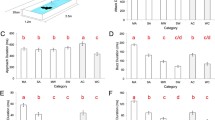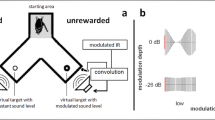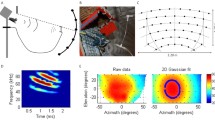Abstract
A stereotyped approach phase vocalization response of Noctilio albiventris to artificial echoes simulating a virtual approaching object was used to assess the ability of the bat to analyze and extract distance information from the artificial echoes. The performance of the bats depended on the temporal pattern of frequency change of the continuously sweeping frequency modulated (FM) component of the signals. When the bats were presented with a CF/FM signal containing a time-reversed upward FM sweep, they responded with approach phase behavior at a performance level that was significantly below that seen with a CF/FM signal containing a naturally structured downward FM sweep. When the FM sweep was divided into a series of brief pure tone steps, the extent to which the bats showed a difference in their capability to process upward versus downward FM sweeps depended on the difference in frequency between the pure tone steps. The bats effectively processed downward but not upward FM sweeps when the difference in frequency between pure tone frequency elements of the FM sweeps was from about 100–200 Hz, but they effectually processed both downward and upward FM sweeps when the tonal elements composing the FM sweeps were separated by more than about 200 Hz. This suggests that the ability of the bats to effectively process downward but not upward FM sweeps is based on local interactions between adjacent frequency elements of the complex sounds.
Similar content being viewed by others
Abbreviations
- CF :
-
constant frequency
- FM :
-
frequency modulated
References
Griffin DR (1958) Listening in the dark. Yale Univ Press, New Haven
Hartley DJ (1992) Stabilization of perceived echo amplitudes in echolocating bats. II. The acoustic behavior of the big brown bat, Eptesicus fuscus, when tracking moving prey. J Acoust Soc Am 91:1133–1149
Masters WM, Jacobs SC (1989) Target detection and range resolution by the big brown bat (Eptesicus fuscus) using normal and time-reversed model echoes. J Comp Physiol A 166:65–73
Roverud RC (1987) The processing of echolocation sound elements in bats: a behavioural approach. In: Fenton MB, Racey P, Rayner JMV (eds) Recent advances in the study of bats. Cambridge Univ Press, Cambridge, pp 152–170
Roverud RC (1993) Neural computations for sound pattern recognition: evidence for summation of an array of frequency filters in an echolocating bat. J Neurosci 13:2306–2312
Roverud RC (1994) Complex sound analysis in the lesser bulldog bat: evidence for a mechanism for processing frequency elements of frequency modulated signals over restricted time intervals. J Comp Physiol A 174:559–565
Roverud RC, Grinnell AD (1985a) Discrimination performance and echolocation integration requirements for target detection and distance determination in the CF/FM bat, Noctilio albiventris. J Comp Physiol A 156:447–456
Roverud RC, Grinnell AD (1985b) Echolocation sound features processed to provide distance information in the CF/FM bat, Noctilio albiventris: evidence for a gated time window utilizing both CF and FM components. J Comp Physiol A 156:457–469
Simmons JA (1973) The resolution of target range by echolocating bats. J Acoust Soc Am 54:157–173
Simmons JA, Grinnell AD (1988) The performance of echolocation: acoustic images perceived by echolocating bats. In: Nachtigall PE, Moore PWB (eds) Animal sonar: processes and performance. Plenum, New York, pp 353–386
Suga N (1965a) Analysis of frequency-modulated sounds by auditory neurones of echo-locating bats. J Physiol (Lond) 179:26–53
Suga N (1965b) Functional properties of auditory neurones in the cortex of echo-locating bats. J Physiol (Lond) 181:671–700
Surlykke A (1992) Target ranging and the role of time-frequency structure of synthetic echoes in big brown bats, Eptesicus fuscus. J Comp Physiol A 170:83–92
Vaughan TA (1970) Flight patterns and aerodynamics. In: Wimsatt WA (ed) Biology of bats, vol I. Academic P, New York, pp 195–216
Author information
Authors and Affiliations
Rights and permissions
About this article
Cite this article
Roverud, R.C. Frequency modulated sound pattern analysis in the lesser bulldog bat: the role of interactions between adjacent frequency elements of complex sounds. J Comp Physiol A 176, 1–9 (1995). https://doi.org/10.1007/BF00197747
Accepted:
Issue Date:
DOI: https://doi.org/10.1007/BF00197747




